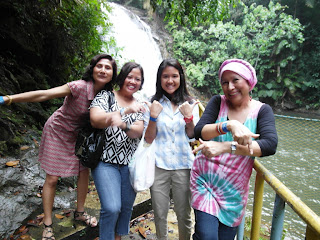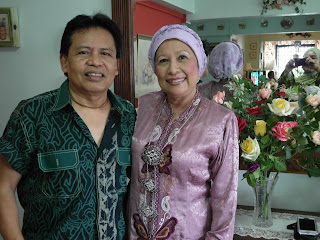 |
| The Kota Tinggi Waterfall |
 |
| Cooling and refreshing air |
 |
| The waterfall cascading down with a splash |
 |
| Brother Yusuf and his wife, Rare Rose |
 |
| The flight of water behind me |
 |
| Weak lines caused by erosive power of the river |
 |
| Urbanites getting close to nature |
 |
| A monkey making faces at us |
 |
| Soaking in the beautiful scenery |
 |
| The water-theme recreational facilities |
 |
| Continous flow of water as the backdrop |
 |
| Crouching tigers on the loose |
 |
| Beauties by the fall |
 |
| Breaking out into a Opa Kota Tinggi Gangnam style |
 |
| Fly me to the moon |
 |
| At the upper part of the fall |
 |
| At the shallower part of the fall |
 |
| Making friends with the locals |
 |
| Many shops are found at the town |
 |
| Map of the town |
 |
| Seafood dinner of prawns, crabs and squids Feasted on these dishes |
 |
| Firefly cruise as the night drew near |
Kota Tinggi Waterfall
A short retreat to Kota Tinggi was planned a few days ahead. We left Singapore at 8.00am, stopped by at Taman Austin for breakfast before continuing the 62 km journey from Johor Bahru to Kota Tinggi Waterfall. We followed the directional signs along the Kota Tinggi Road and turned left to Kota Tinggi town. Crossing a bridge, we passed by oil palm plantations and headed for another 16km to reach the fall. Cheeky monkeys slowed down our drive as they had mistaken the road for their foliage playground.
Kota Tinggi Waterfall is also known as the Lombong Fall. It is also a favourite spot among the locals and for school excursion trips with its pristine forests and jungle tracks. With a height of 36 metres, the vertical rock-faced cascading waterfall has its source from Mount Panti. Decades ago, the entry to this place was free. Now entrance fee is RM9 per person while parking fee is RM5 per car.
This was my second trip in recent years. But when I was a child, I used to come here for family picnics. Thick vegetation surrounded the area giving it a damp and dank atmosphere. The temperature could leave you shivering to the bone, especially when you leave the pool after having a dip. Sad to say, much of the tropical forest at the lower part of the fall has been cleared now, allowing more light to pass through the canopy. Nevertheless, the refreshing coolness is still welcomed and a great way to beat the heat.
The cool river water drains through a series of shallow pools ideal for swimming. At most the depth of the pool is less than a metre. The natural beauty of some parts of the fall has somewhat been jarringly spoilt by the resort development with artificial landscaping, Almost like a water-themed park, the corresponding stretch of rapid water had been channelled to whisk bathers seeking adventure, down the slide with a huge inflatable tube. These tubes can be hired. Definitely for the thrill-seekers and the children but the untouched upper pools were my favourite location.
Public changing rooms and camping grounds are available for visitors’ convenience. A restaurant nearby was closed on that busy Saturday morning when we arrived. A coffee shop was a saviour to the many picnickers who needed some hot drinks badly on that drizzly day. Burgers and instant noodles were the favourite order from the kids.
Two parts of Kota Tinggi fall are accessible by visitors. The rushing cascading bigger waterfall is at the lower part. Many picnickers prefer this location because it's big and the flat-topped rocks offer a resting perch. Bathers planted themselves at the direct spot where the water falls to ease shoulder pains and for a therapeutic effect.
We explored higher up by climbing the stairs where you will meet with rapids, lower falls and its continuous rush of cascading cool waters that run down the granite more resistant rocks. The surrounding is mainly untouched and in their semi-virginal state. The jungle sounds of crickets, cicadas, frogs, monkeys and birds’ singing received us in an enlivening fashion.
The vegetation gets thicker with ferns, palm and jelutongs up there. I observed lines of weakness and fissures criss-crossing the rocks because of the erosive power of the water. Abrassion, attrition, hydraulic action and solution are the evident eroisve processes along here. A deep plunge pool higher up is out of bounds. There are signboards to caution you from making any head-down plunges into the pools and it has been barricaded by a net; too dangerous to swim in the 10m drop since a number of drowning cases had taken place there.
We chatted with some university students who were having their term break. We couldn’t resist dipping our feet into the inviting crystal clear water which felt cold and heavy. The undergrads mentioned that there is another waterfall nearby – the Pelepah Waterfall which is hidden by the forest and led by a small stream. However, it’s safer to take an experienced guide for that extra adventure to this second waterfall. Before bidding our Malaysian friends goodbye, we break into ‘Opa Kota Tinggi Gangnam’ style with them.
If you are thinking of staying overnight, you have a choice of two resorts – the Rainforest Resort or the Waterfalls Resort. They are surrounded by forested areas and provide a rustic sanctuary embraced by nature. Kota Rainforest Resort is about a five minutes’ drive to the waterfall, more expensive of the two, but looked better and newer than Kota Tinggi Waterfalls Resort, which is right where the waterfall is located.
Our next stop was at Mini Kelantan where you could shop for scarves, baju kurungs, telekungs and anything a makcik would love to part her money with. Most of the shops are owned by Cambodian refugees who have already settled in Malaysia. We spent some time going around the area before heading for a seafood dinner. The night ended with a boat cruise to see firefly along Johore River. The boarding point for the firefly excursion is at the riverbank near Jalan Tepi Sungai, opposite the row of shops. At the fireflies wonderland, you will find these fascinating insects in abundance on the Berembang trees that line the banks of the river. As it was a night excursion, the blinking lights of the fireflies was breathtaking as they skirted above the water surface.



































.JPG)










